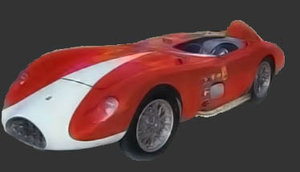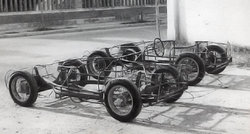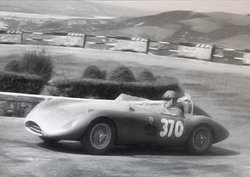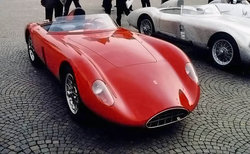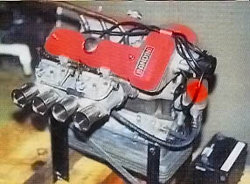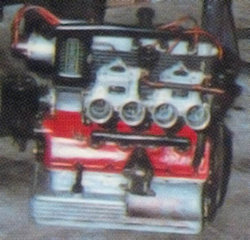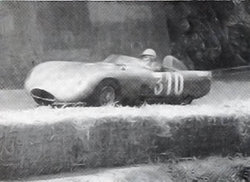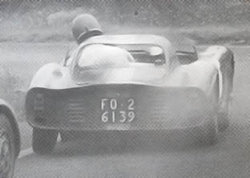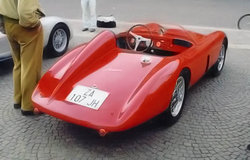Bandini 750 sport internazionale
The Bandini 750 international sport also called simply "Saponetta", is a racing car built from 1957 until 1961 by Bandini Cars.
This new type of car, prepared for categria 750 sports, replaced the production of "sport torpedo. The adjective International wanted to pay tribute to the merits collected from overseas 750 sports torpedo while "bar of soap" is the name under which it was identified by the same Ilario Bandini for its forms, similar to those of just a bar of soap.
As the model which replaced the bar of soap was much in demand USA where it was used both as auto racing that as "out of range" to be submitted to the streets in the city. His debut in the race dates back to Mille Miglia, 1957 (round of World Championship) led by Bruno Garavini, with an engine 750 cm³ Bandini-Crosley updated (second series) especially in the head recognizable for the spinterogeno mounted between the two camshafts and the lids of punterie inclined at 45 ° with glaring longitudinal ribs.
The "Saponetta", maintained the characteristics of simplicity and lightness while improving road holding and penetration aerodynamics. Dote which was exploited in motodromes as the famous circuit Daytona and the ring of high-speed 'Track of Monza.
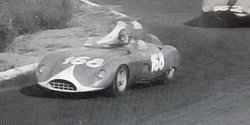
The Story
((Also see Ilario Bandini)) Despite the successes are not missing in USA and races uphill and Italian circuit, the " little bar of soap" initially paid the rapid evolution of regulation in a short time saw the rise of engine capacity to 850 cm³ and then to 1000 cm³. However proved a car fast and successful, able to express themselves at high levels even with higher displacements collecting victories with Gene Parsons, James Eichenlaub (both ex aequo vicecampioni U.S. SCCA in 1958), Dave Lang (third in the final classification 1961 with only four races: three first and second place), Skip Callanan, Paul Richards, Victor Lukens, Jack Connolly, Giorgio Cecchini and Ilario Bandini circuit and up until 1965. Wins's most prestigious given that many car competitors had engine at the rear; choice desitnata to influence the entire motor sports. In this context, it is most important third place to Trento-Bondone in 1964 (valid for the European championship mountain) and fourth place to Mugello circuit road, 1965 (Round of World Championships sports) both obtained by Antonio Benelli.
Today, nine "Saponetta" remained, one is exposed to the museum Marconi Los Angeles, two are stored in the museum Bandini Forlì.
The Chassis
The chassis construction Bandini, while using the same type of elements of 750torpedo, is modified in size and weight distribution. Increase wheelbase and roadways, the height from the ground is significantly reduced and also the position of the driver is considerably lowered. The engine compartment, largest, will allow the housing of the subsequent engine 850 and 1000 cm³. The rear suspension has been enhanced with an anti-tramp and, in some exceptions, of a system with wheels independent.
- Structure and material: frame of elliptical section tubes, special steel aeronautics derivation; patent No. 499843
- Wheelbase: 2100 mm
- Suspensions:
- Braking system:
- Service: hydraulics, drum autoventilanti front and lighted
- Parking Mechanical tape, on ' transmission shaft
- Steering: a worm with vibration damper on shaft
- Guide: on the left (right upon request)
- Wheels: ray Borrani 15 "or 12"
- Tyres: 4.25x15 / 5.20x12 "
- Tank: 45 Litres
- Transmission: transmission shaft with joints cardanici, differential Central and semiassi the rear
- Weight: bare chassis 21 kg
- Weight total: 340-390 kg
- Speed maximum: 185 km / h (750 cc), 200 km / h (1000 cc)
The Engines
The Saponetta was born with the engine Bandini-Crosley 750 cm³ but from 1959 was also used with engines 850 cm³ and 1000, the first engines built completely with Bandini the transmission chain, whose project is dated 1955. There are also copies that are running with engines Saab and Ford.
Bandini Crosley 750-second series
- Positioning: forward longitudinal, 4-cylinder in-line
- Materials and particularity: base 5 media bench and alloy sump of 5 litres capacity, head alloy DOHC, Distribution gear double overhead camshaft, 8 inclined valves, cylinders detachable ironcasted block.
- Bore: 63.5 mm
- Stroke: 59 mm
- Displacement: 747 cm ³
- Compression ratio: 9,4:1
- Power: 2 Weber carburetors double body 35DCO3
- Power: 68 to 71 hp @ 8500 rpm
- Lubricate: Carter with wet gear pump and filter external wire mesh, alloy cooler
- Cooling: forced liquid with centrifugal pump controlled by pulley and belt, cooler on the front
- Gearbox and clutch: 4 speed + RG, clutch single dry disc
- Ignition and electrical equipment: coil and distributor switch on the head, battery 12 V and generator
Bandini 1000
- Positioning: forward longitudinal, 4-cylinder in-line
- Materials and particularity: double camshaft transmission of motion a chain and gears head Alloy chamber burst hemisphere, block and base five media bench unique fusion of alloy, sump in reeds of cylinders in iron chrome and detachable
- Bore: 68 mm
- Stroke: 68 mm
- Displacement: 987 cm ³
- Compression ratio: 9,5:1
- Power: 2 Weber carburetors double body 38DCO3
- Power: 90 CV @ 7200 rpm
- Lubricate: Carter with wet gear pump and filter external radiator in aluminium
- Cooling: forced liquid with centrifugal pump controlled by pulley and belt, cooler
- Currency and clutch: 4 speed +RG, clutch single dry disc
- Ignition and electrical equipment: coil and distributor switch on the head, battery 12 V and generator
The Body
The bodywork in aluminium open two-seater (boat) are built in Forlì by Bandini. Since the first copy to the type, have undergone radical changes also in the queue: in the first version appeared laterally two vertical fins, some have a truncated tail, in the final model is elongated, low and clean. The front instead appears definitive if not minor differences in the form of air-intake front, a composition of an ellipsoid and a half circle. Significant between a model and the other is the air vent hot side of the engine compartment, sometimes rectangular smoothed trapezoid, parallelogram single or double. Always an air directed inside the (cylindrical opening with about half side) characterizes the car with which he ran Ilario Bandini. It varies considerably height or shape of windshield while a mobile bulkhead may be mounted on cockpit to reduce aerodynamic drag. The same attention was paid to the rear wheels that could be covered half a removable bulkhead. In this respect is curious to see how the rule which introduced the use of roll-bar may have been exploited to create a fairing which seems to have the function of a wing.
Related Items
External Links
| Bandini Automobili | |
|---|---|
| Barchette: "La prima" 1100/46 | 1100 sport | 1100 Siluro (Torpedo) | Bandini-Maserati 1500 | 750 sport Siluro (Torpedo) | 750 sport internazionale "saponetta"
Formula: Formula 3 | Formula junior
|
